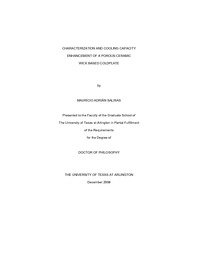
ATTENTION: The works hosted here are being migrated to a new repository that will consolidate resources, improve discoverability, and better show UTA's research impact on the global community. We will update authors as the migration progresses. Please see MavMatrix for more information.
Show simple item record
| dc.contributor.author | Salinas, Mauricio Adrian | en_US |
| dc.date.accessioned | 2009-09-16T18:19:00Z | |
| dc.date.available | 2009-09-16T18:19:00Z | |
| dc.date.issued | 2009-09-16T18:19:00Z | |
| dc.date.submitted | January 2008 | en_US |
| dc.identifier.other | DISS-10035 | en_US |
| dc.identifier.uri | http://hdl.handle.net/10106/1723 | |
| dc.description.abstract | Current passive cooling methods of aerospace and military, high heat-flux electronics include the use of thermal planes made of exotic metal alloys, which have been designed, at a great expense, to have high thermal conductivity and low density (i.e. light weight). Also, phase change modules composed of a metal matrix saturated with a solid phase change material are being employed for systems requiring a transient cooling scheme such as expendable weapons. This method requires the heat to be transferred from the source location, through the metal matrix (typically a porous aluminum foam), to the available phase change material. Preliminary empirical evaluations performed at Raytheon's Space and Airborne Systems indicate that wick-based coldplates including a non-metallic porous medium, saturated with fluid may be much more effective. This wick-based method allows the capillary action of the wick to passively transport liquid from liquid-rich areas to the point of need, a much more efficient process. The objective of this research was to characterize the mass and heat transport of this proposed non-metallic, wick-based coldplate. Mass transport was characterized by measuring the wickability (liquid penetration into porous media) between the proposed working fluids and porous medium. This was accomplished by employing the two most common techniques, the height and weight approaches. The height approach requires the measurement of distance penetrated by the liquid into the porous medium, while the weight approach tracks the mass gained by the pores due to imbibition. Experimental data was analyzed through Washburn's Theory. Heat transport was characterized by measuring the transient cooling capacity and the steady state thermal resistance of the proposed wick-based coldplate. For these evaluations, an aluminum oxide based ceramic served as the porous medium with the following working fluids: water, methanol, ethanol, methanol-water mixtures, ethanol-water mixtures, and a fluorinert liquid FC-72. | en_US |
| dc.description.sponsorship | You, Seung Mun | en_US |
| dc.language.iso | EN | en_US |
| dc.publisher | Mechanical Engineering | en_US |
| dc.title | Characterization And Cooling Capacity Enhancement Of A Porous Ceramic Wick Based Coldplate | en_US |
| dc.type | Ph.D. | en_US |
| dc.contributor.committeeChair | You, Seung Mun | en_US |
| dc.degree.department | Mechanical Engineering | en_US |
| dc.degree.discipline | Mechanical Engineering | en_US |
| dc.degree.grantor | University of Texas at Arlington | en_US |
| dc.degree.level | doctoral | en_US |
| dc.degree.name | Ph.D. | en_US |
| dc.identifier.externalLink | http://www.uta.edu/ra/real/editprofile.php?onlyview=1&pid=262 | |
| dc.identifier.externalLinkDescription | Link to Research Profiles | |
Files in this item
- Name:
- Salinas_uta_2502D_10035.pdf
- Size:
- 17.65Mb
- Format:
- PDF
This item appears in the following Collection(s)
Show simple item record


